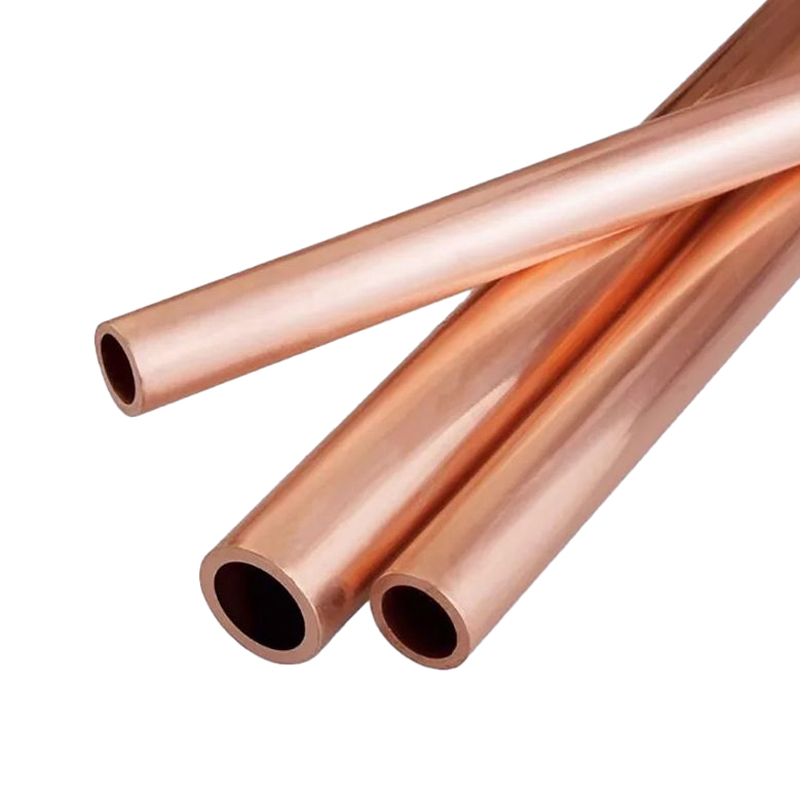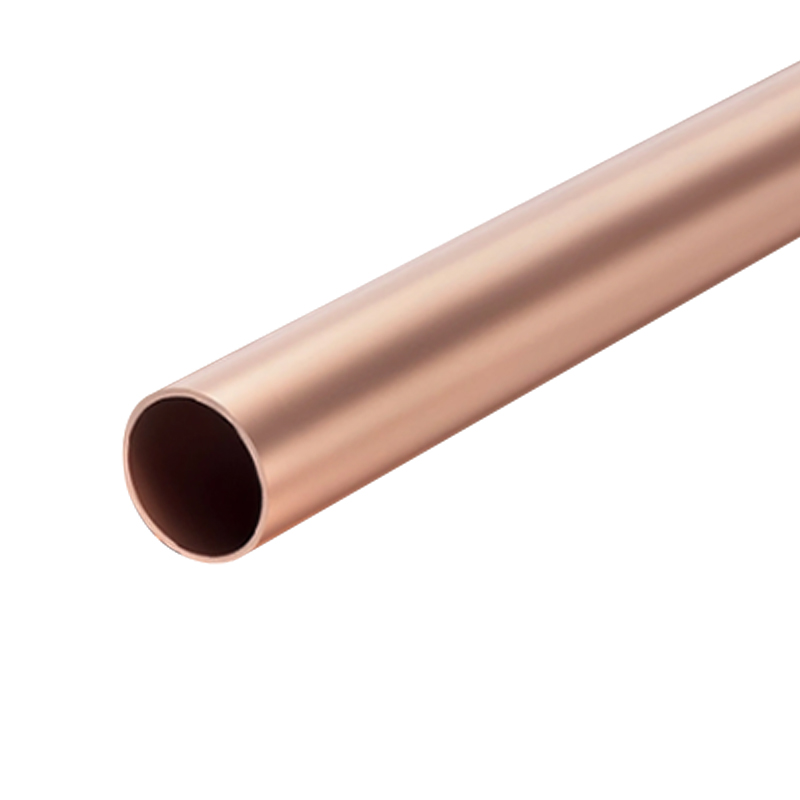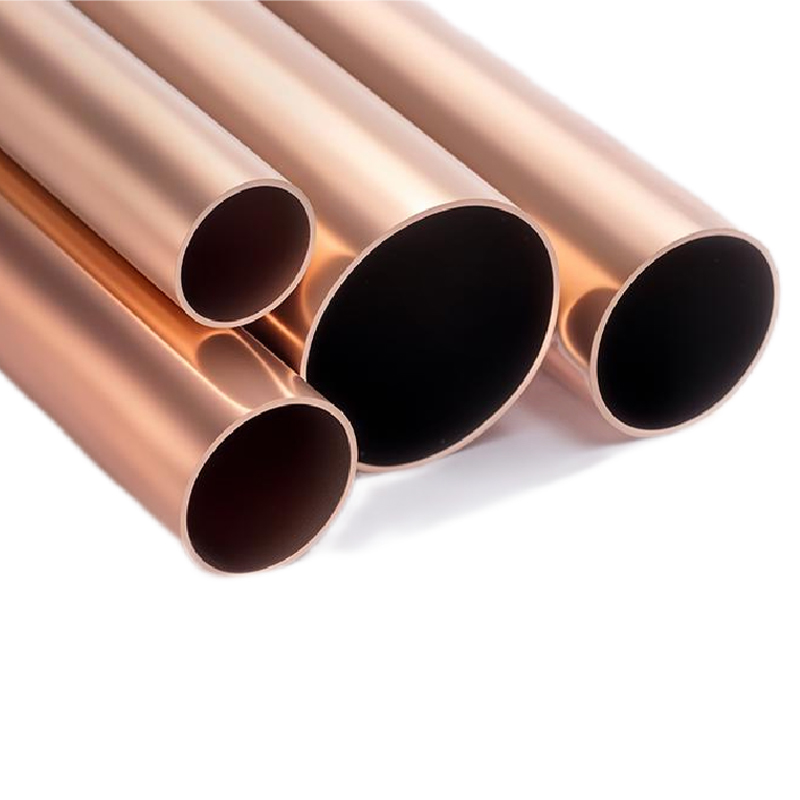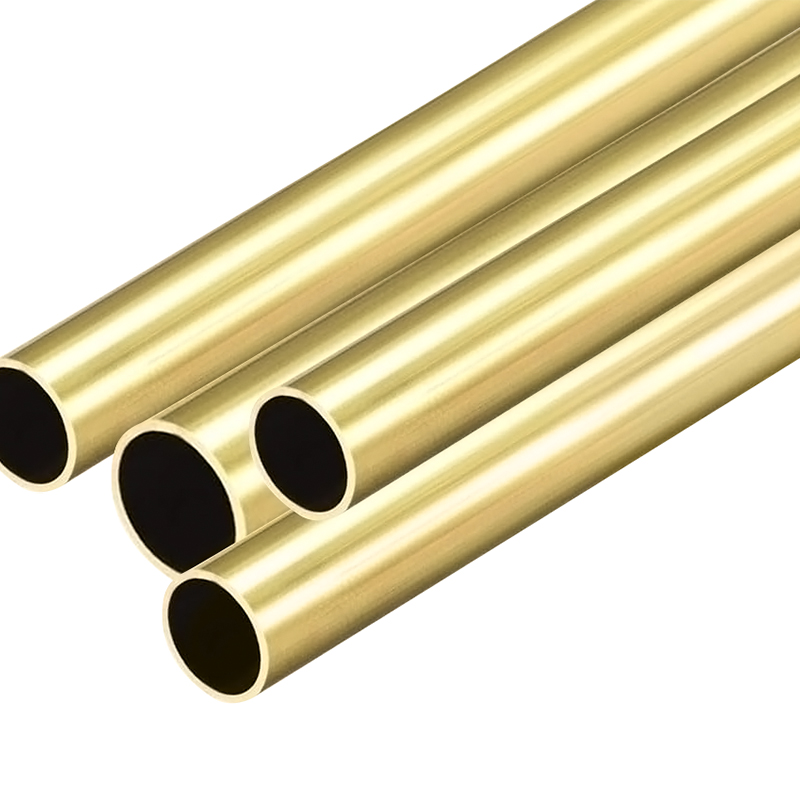Thick-walled copper tubes are also called seamless thick-walled copper tubes. Thick-walled copper tubes are manufactured by a hot extrusion process, with a wall thickness of usually more than 2mm, and exhibit structural strength and compressive strength. The product cross-section is mainly round, and square or other special-shaped structures can also be customized according to customer needs. It is widely used in engineering environments that require high mechanical strength and corrosion resistance. The product has good thermal conductivity, strong corrosion resistance, and high sealing. It is suitable for the transportation of high-pressure refrigerants in refrigeration and air-conditioning systems, as well as systems in the chemical and energy fields that have strict requirements on fluid transportation safety. In architecture and industrial design, thick-walled copper tubes are also often used to process load-bearing structures, system tubelines, or customized components.
ABOUT US
30+YEARS OF
EXPERIENCE
About Us
A Reliable Partner of the Copper Tube Industry
Zhejiang Jingliang Copper-Tube Products Co., Ltd established in 1994, is China Thick Wall Copper Tube Manufacturers and Custom Thick Wall Copper Tube Suppliers, has been deeply involved in the copper tube industry for over three decades. The company primarily produce various specifications of products such as copper tubes, brass tubes, copper square tubes, fin copper tubes, copper capillary tubes, condenser copper tubes, copper evaporator tubes, and conductive rods, which are of quality and have earned the trust and acclaim of customers both domestically and internationally.
Wide Applications:
These products are widely used in various fields including air conditioning, refrigeration, heat exchange, sanitary ware, automotive, machinery, electric furnaces, and chemical industries.
Convenient Transportation:
Strategically located in Tangpu Town, renowned as the “home of copper tubes” in East China. Our company enjoys a prime location, adjacent to the Shangsan Expressway and National Highway 104, and is conveniently situated just over 70 kilometers from Hangzhou and Ningbo, ensuring easy accessibility and a business position.
Strong Financial Resources:
With its strong financial resources and advanced copper tube processing technology, our company holds an advantageous position in market share, brand value, technological content, and product quality, becoming a preferred supplier for many listed groups.
Large Scale Production:
The company occupies an area of over 20,000 square meters, with a construction area of 12,800 square meters. In 2022, our annual production exceeded 7,500 tons, with a value output of up to 450 million yuan, demonstrating our strong production capacity and market competitiveness.
Comprehensive Industry Chain:
Jingliang has now developed into a complete industrial chain integrating smelting, extrusion, drawing, precision rolling, and annealing. It has been awarded multiple honors, including "Top Ten Copper Tube Enterprises" and "Leading Taxpayer in the Copper Tube Industry".
Smart Manufacturing:
Jingliang Copper-Tube Products will better integrate the concept of factory construction into its corporate development strategy, insist on refining technology and polishing products more finely, and the future of "intelligent manufacturing".
Genuine Cooperation:
Zhejiang Jingliang Copper-Tube Products Co.,Ltd warmly welcomes friends from all walks of life to visit and offer guidance. We look forward to joining hands with you to create a brilliant future together.
Technical skills
Production Process
- 1、Electrolytic Copper
- 2、Copper Ingots
- 3、Press
- 4、Drawing
- 5、Rolling
- 6、Packaging
Electrolytic copper, produced through electrolytic processes, is a high-purity copper with good electrical conductivity and thermal conductivity, making it an ideal material for manufacturing copper pipes.
This marks the beginning of our production process, which involves the fabrication of electrolytic copper into pure copper or brass ingots according to specific requirements, followed by cutting to facilitate subsequent processing and handling.
In the pressing stage, the cut copper ingots are pressed into thin sheets or tubular shapes, forming the initial tube shape, and the copper ingots are prepared for drawing and rolling.
Drawing is the process of further processing the copper sheets or tubular objects that have been pressed into the required dimensions and shapes. Through drawing, our copper tubes can achieve precise outer diameters and wall thicknesses.
Rolling is the step of further processing the copper tubes after drawing. Through rolling, the copper tubes are rolled into more precise dimensions and shapes to meet the requirements of different applications.
Finally, the copper tubes that have undergone rolling will be packaged and prepared for shipping. We ensure that the packaging is safe and protective to prevent damage during transportation.
News
-
Copper Tube Industry Segmentation Report: How Are Niche Markets Reshaping the Competitive Landscape?
Subtitle: While traditional copper tubes grapple with price wars, segments like semiconductor-grade oxygen-free copper tubes and ultra-thin wall tubes for new energy vehicles achieve 30%+ gross margins—how do these niche products, represent...
READ MORE -
In the world of heat exchangers, air conditioning systems, refrigeration units, and other thermal management applications, the choice of materials for the tubes that facilitate heat transfer is crucial. Copper and aluminum are two of the mo...
READ MORE -
Refrigeration systems are essential in modern-day life, from preserving food and medicine to maintaining the comfort of our homes and workplaces. One of the key components that ensure the efficient operation of these systems is the capillar...
READ MORE
Industry knowledge
What are the common connection methods of thick wall copper tube?
As an important industrial material, thick wall copper tube is widely used in air conditioning, heat exchange, chemical industry, power and other fields due to its excellent mechanical properties and corrosion resistance. With the continuous upgrading of industry demand, the connection methods of thick wall copper tubes are becoming increasingly diversified and specialized, becoming a key link to ensure system safety, efficiency and life.
The importance of thick wall copper tube connection methods
Thick wall copper tubes are usually used in high pressure, high temperature and complex working conditions. The sealing and mechanical strength of the connection parts directly affect the safety and stability of the entire system. Reasonable connection methods can not only improve the pressure resistance of the pipeline, but also effectively prevent leakage and corrosion, and extend the life of the pipeline. Therefore, choosing a suitable connection process is the technical core in the application of thick wall copper tubes.
Overview of common connection methods
Combined with Zhejiang Jingliang Copper-Tube Products Co., Ltd.'s more than 30 years of copper tube manufacturing experience, the connection methods of thick wall copper tubes mainly include welding connection, mechanical crimping, flange connection and threaded connection. The following details the characteristics and application scenarios of each method.
1. Welding connection
Welding is one of the most common and reliable connection methods for thick wall copper tubes. There are mainly three types: copper welding (soft soldering), silver welding (hard soldering) and brazing.
Copper welding is suitable for systems with low pressure and low temperature. The welding process is simple and the cost is low, but the connection strength is limited.
Silver welding is widely used in air conditioning refrigeration and high-pressure pipelines due to its high melting point and good connection strength. Zhejiang Jingliang Copper-Tube Products Co., Ltd relies on advanced welding technology and strict process control to ensure the quality of welds and meet the needs of various complex working conditions.
Brazing is commonly used in heat exchangers and air-conditioning systems. It can form an extremely airtight connection to ensure long-term stable operation of the system.
The advantage of welding connection is that there are no mechanical parts at the connection, which reduces the risk of leakage, has high connection strength, and is suitable for various complex shapes and high-pressure environments. Relying on its complete industrial chain, Zhejiang Jingliang produces high-quality copper tubes from smelting, extrusion to drawing, providing a solid material foundation for welding connections.
2. Mechanical crimping
Mechanical crimping technology is a non-welding connection method that uses special crimping tools to press the pipe fittings to achieve sealing and fixation. It has the advantages of fast construction speed, no need for heat source, environmental protection and safety, and is especially suitable for on-site maintenance and emergency repairs.
Zhejiang Jingliang provides thick wall copper tubes of various specifications, combined with industry-standard crimping parts, to meet the needs of air conditioning, refrigeration and mechanical equipment for convenient connection. Mechanical crimping connections are usually suitable for medium and low pressure pipelines, but driven by modern intelligent manufacturing, Zhejiang Jingliang is also continuously developing high-performance crimping technology to cope with more stringent industrial applications.
3. Flange connection
The flange connection combines the flange plate with the end of the thick wall copper tube, and realizes the disassembly and sealing of the pipeline by bolting. This connection method is suitable for pipeline systems that require frequent disassembly and maintenance, such as large chemical equipment and machinery manufacturing.
Zhejiang Jingliang provides a stable pipe material foundation for flange connection with its rich product specifications and precise dimensional control. It cooperates with mechanical processing at the end of the pipeline to ensure the sealing and mechanical strength of the flange connection, meeting the customized needs of high-end industrial customers.
4. Threaded connection
The threaded connection completes the sealing through the threaded engagement between the pipe fittings. It is suitable for small and medium-caliber thick wall copper pipes and is easy to install and disassemble. This method is often seen in the auxiliary parts of the pipeline system, such as instrument connections and small pipelines.
Zhejiang Jingliang relies on precise drawing technology to ensure the strict tolerance of the outer diameter and wall thickness of the copper tube, providing a good foundation for thread processing, and improving the reliability and sealing effect of the connection.
What are the internal and external surface treatment processes of thick wall copper tubes?
The importance of internal and external surface treatment processes of thick wall copper tubes
thick wall copper tubes are widely used in air conditioning, heat exchange, automobile manufacturing, chemical equipment and other fields. The quality of the internal and external surfaces of the pipes is directly related to the thermal conductivity, anti-corrosion performance and service life of the system. Good surface treatment can not only effectively prevent oxidation and corrosion, but also reduce fluid resistance and ensure stable and efficient operation of the pipeline system. Therefore, the reasonable selection and control of internal and external surface treatment processes is an important technical link in the production of thick wall copper tubes.
External surface treatment process of thick wall copper tubes
1. Surface polishing and cleaning
The outer surface of thick wall copper tubes is usually first mechanically polished to remove scale, burrs and surface defects during extrusion and drawing. Zhejiang Jingliang relies on its precision rolling and annealing equipment to ensure that the surface of the pipe is smooth and flat, laying a solid foundation for subsequent processing. After polishing, the copper tubes also need to undergo rigorous chemical cleaning to remove grease and impurities and prevent surface contamination.
2. Surface passivation treatment
Passivation treatment is a process that forms a thin and dense oxide film through chemical methods to enhance the corrosion resistance of the copper tube surface. Zhejiang Jingliang uses advanced passivation liquid formula and automated processing lines to ensure that the oxide film on the surface of each copper tube is uniform and stable, effectively preventing the copper material from oxidizing and discoloring during storage and transportation, and improving the appearance quality and durability of the product.
3. Anti-oxidation coating
In response to the needs of high-end customers, Zhejiang Jingliang also provides external surface anti-oxidation coating treatment, including transparent protective paint and special anti-corrosion coating. These coatings can effectively isolate air and moisture, further enhance the anti-oxidation performance of copper tubes, and are especially suitable for hot and humid environments and marine climate areas.
4. Surface marking and inkjet printing
In order to meet the needs of market traceability and brand recognition, Zhejiang Jingliang has also continuously innovated in surface inkjet printing technology, using environmentally friendly and wear-resistant inkjet equipment to ensure clear markings without affecting the surface performance of the pipe.
Inner surface treatment process of thick wall copper tubes
1. Inner wall cleaning and degreasing
The inner wall of thick wall copper tubes is prone to residual lubricants, oxides and metal chips during the manufacturing process. Zhejiang Jingliang uses high-efficiency inner wall cleaning equipment, combined with ultrasonic and chemical cleaning processes, to thoroughly remove impurities on the inner wall, ensure the cleanliness of the tube, and provide guarantees for subsequent processes and applications.
2. Inner wall anti-corrosion treatment
In order to extend the service life of copper tubes, especially in chemical and refrigeration systems, inner wall anti-corrosion treatment is particularly critical. Zhejiang Jingliang introduces advanced inner wall spraying technology, which can evenly apply a variety of anti-corrosion coatings, such as epoxy resin coatings and special anti-corrosion films, effectively resist the erosion of corrosive media, and prevent scaling and clogging.
3. Inner wall polishing and smoothing
Through mechanical polishing or electrochemical polishing, Zhejiang Jingliang can significantly reduce the roughness of the inner wall, reduce fluid resistance, and improve heat transfer efficiency and system performance. This process is particularly important in heat exchangers and high-efficiency refrigeration equipment.
4. Inner wall inspection and quality control
Combined with the company's intelligent manufacturing concept, Zhejiang Jingliang uses advanced non-destructive testing technology to conduct online inspection of the inner wall to ensure that there are no cracks, inclusions and holes, and to ensure that the inner surface quality meets international standards and customer requirements.
What are the welding processes and precautions for thick wall copper tubes
Overview of thick wall copper tube welding process
Welding is the process of joining copper tube materials into a continuous whole through heating or pressure. The main welding methods include brazing (soft soldering and hard soldering), fusion welding (arc welding, argon arc welding), etc. Due to the large wall thickness, thick wall copper tubes require higher control of the welding process. It is necessary to ensure the sealing and mechanical strength of the weld to prevent welding defects from causing pipeline leakage or breakage.
Zhejiang Jingliang relies on its complete production processes such as smelting, extrusion, drawing and finishing rolling to produce high-quality thick wall copper tubes, providing a stable raw material base for the welding process. At the same time, the company combines intelligent manufacturing technology to accurately control welding parameters to ensure welding quality and product consistency.
Common welding processes for thick wall copper pipes
1. Brazing process
Brazing is to melt the filler metal (braze) by heating, fill it into the gap of the copper pipe joint, and realize the bonding between metals. Brazing is divided into soft soldering and hard soldering:
Soft soldering uses low melting point alloys (such as tin-based alloys) and is suitable for pipeline systems with low pressure and low temperature. Its process is simple and the cost is low, but the welding strength is limited.
Hard soldering (silver brazing) uses silver-based alloys as solder, which has a high melting point, excellent weld strength and corrosion resistance, and is widely used in air conditioning and refrigeration and high-pressure pipelines. Zhejiang Jingliang has achieved high-precision temperature control and welding environment management in the brazing process to ensure uniform penetration of the brazing material and dense welds.
2. Fusion welding process
Fusion welding is to melt part of the copper pipe base material by heating to achieve molten metal bonding. Common fusion welding methods include arc welding and argon arc welding:
Arc welding is suitable for welding thicker copper pipes and can ensure high welding speed and strength.
Argon arc welding uses inert gas to protect the welding area to prevent oxidation, with high weld quality and flexible welding process, which is particularly suitable for occasions with high requirements for weld beauty and performance.
Zhejiang Jingliang combines modern automation equipment to strictly control welding current, voltage and shielding gas flow to ensure stable and reliable welding process.
Key points for thick wall copper tube welding process
1. Preparation before welding
The guarantee of welding quality starts with preliminary preparation. Before welding thick wall copper tubes, the welding surface must be thoroughly cleaned to remove oil, scale and other impurities. Zhejiang Jingliang uses efficient chemical cleaning and mechanical polishing technology to ensure that the weld is clean and smooth and reduce the risk of welding defects.
2. Welding parameter control
Parameters such as welding temperature, speed, and shielding gas flow need to be precisely controlled. Excessive temperature can easily lead to overburning of copper or coarse grains, affecting the strength of the weld; too low temperature cannot form a good weld. Zhejiang Jingliang monitors and adjusts welding parameters in real time through an intelligent manufacturing system to ensure the stability of the welding process.
3. Weld design and fixture fixation
The welds of thick wall copper pipes are usually butt-welded, and the weld surface should be processed into an appropriate groove to ensure full penetration of the brazing material or welding wire. Use professional fixtures to fix the pipes during welding to prevent deformation and dislocation, and ensure that the size and shape of the weld meet the design requirements.
4. Welding environment and safety protection
The welding site should be kept clean and well ventilated to avoid the accumulation of welding smoke and harmful gases. Protective equipment is used to ensure the safety of operators, while avoiding the influence of oxygen and moisture in the air on the weld during welding.
5. Post-weld treatment and quality inspection
After welding, the weld needs to be cleaned and annealed in time to eliminate stress and improve the toughness of the weld. Zhejiang Jingliang uses advanced non-destructive testing technologies, such as X-ray flaw detection and ultrasonic testing, to ensure that the weld is free of defects such as cracks and pores, in line with international and customer standards.

 English
English Español
Español




